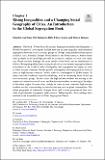Files in this item
Rising inequalities and a changing social geography of cities. An introduction to the global segregation book
Item metadata
| dc.contributor.author | van Ham, Maarten | |
| dc.contributor.author | Tammaru, Tiit | |
| dc.contributor.author | Ubarevičienė, Rūta | |
| dc.contributor.author | Janssen, Heleen | |
| dc.contributor.editor | van Ham, Maarten | |
| dc.contributor.editor | Tammaru, Tiit | |
| dc.contributor.editor | Ubarevičienė, Rūta | |
| dc.contributor.editor | Janssen, Heleen | |
| dc.date.accessioned | 2021-03-30T13:30:02Z | |
| dc.date.available | 2021-03-30T13:30:02Z | |
| dc.date.issued | 2021-03-30 | |
| dc.identifier | 273541224 | |
| dc.identifier | b3c29c70-6cf6-47de-82a5-83e69dc7ea58 | |
| dc.identifier | 85103536604 | |
| dc.identifier.citation | van Ham , M , Tammaru , T , Ubarevičienė , R & Janssen , H 2021 , Rising inequalities and a changing social geography of cities. An introduction to the global segregation book . in M van Ham , T Tammaru , R Ubarevičienė & H Janssen (eds) , Urban socio-economic segregation and income inequality : a global perspective . The urban book series , Springer , Cham , pp. 3-26 . https://doi.org/10.1007/978-3-030-64569-4_1 | en |
| dc.identifier.isbn | 9783030645687 | |
| dc.identifier.isbn | 9783030645694 | |
| dc.identifier.issn | 2365-757X | |
| dc.identifier.other | RIS: urn:AF332E6CD545CADC89BCE35324F35611 | |
| dc.identifier.other | RIS: van Ham2021 | |
| dc.identifier.other | ORCID: /0000-0002-2106-0702/work/91685567 | |
| dc.identifier.uri | https://hdl.handle.net/10023/21739 | |
| dc.description.abstract | The book “Urban Socio-Economic Segregation and Income Inequality: a Global Perspective” investigates the link between income inequality and residential segregation between socio-economic groups in 24 large cities and their urban regions in Africa, Asia, Australia, Europe, North America, and South America. Author teams with in-depth local knowledge provide an extensive analysis of each case study city. Based on their findings, the main results of the book can be summarised as follows. Rising inequalities lead to rising levels of socio-economic segregation almost everywhere in the world. Levels of inequality and segregation are higher in cities in lower income countries, but the growth in inequality and segregation is faster in cities in high-income countries, which leads to a convergence of global trends. In many cities the workforce is professionalising, with an increasing share of the top socio-economic groups. In most cities the high-income workers are moving to the centre or to attractive coastal areas, and low-income workers are moving to the edges of the urban region. In some cities, mainly in lower income countries, high-income workers are also concentrating in out-of-centre enclaves or gated communities. The urban geography of inequality changes faster and is more pronounced than city-wide single-number segregation indices reveal. Taken together, these findings have resulted in the formulation of a Global Segregation Thesis. | |
| dc.format.extent | 24 | |
| dc.format.extent | 771663 | |
| dc.language.iso | eng | |
| dc.publisher | Springer | |
| dc.relation.ispartof | Urban socio-economic segregation and income inequality | en |
| dc.relation.ispartofseries | The urban book series | en |
| dc.subject | Socio-economic segregation | en |
| dc.subject | Income inequality | en |
| dc.subject | Residential segregation | en |
| dc.subject | Global segregation thesis | en |
| dc.subject | G Geography (General) | en |
| dc.subject | GF Human ecology. Anthropogeography | en |
| dc.subject | H Social Sciences (General) | en |
| dc.subject | SDG 10 - Reduced Inequalities | en |
| dc.subject.lcc | G1 | en |
| dc.subject.lcc | GF | en |
| dc.subject.lcc | H1 | en |
| dc.title | Rising inequalities and a changing social geography of cities. An introduction to the global segregation book | en |
| dc.type | Book item | en |
| dc.contributor.institution | University of St Andrews. School of Geography & Sustainable Development | en |
| dc.contributor.institution | University of St Andrews. Population and Health Research | en |
| dc.identifier.doi | https://doi.org/10.1007/978-3-030-64569-4_1 |
This item appears in the following Collection(s)
Items in the St Andrews Research Repository are protected by copyright, with all rights reserved, unless otherwise indicated.

